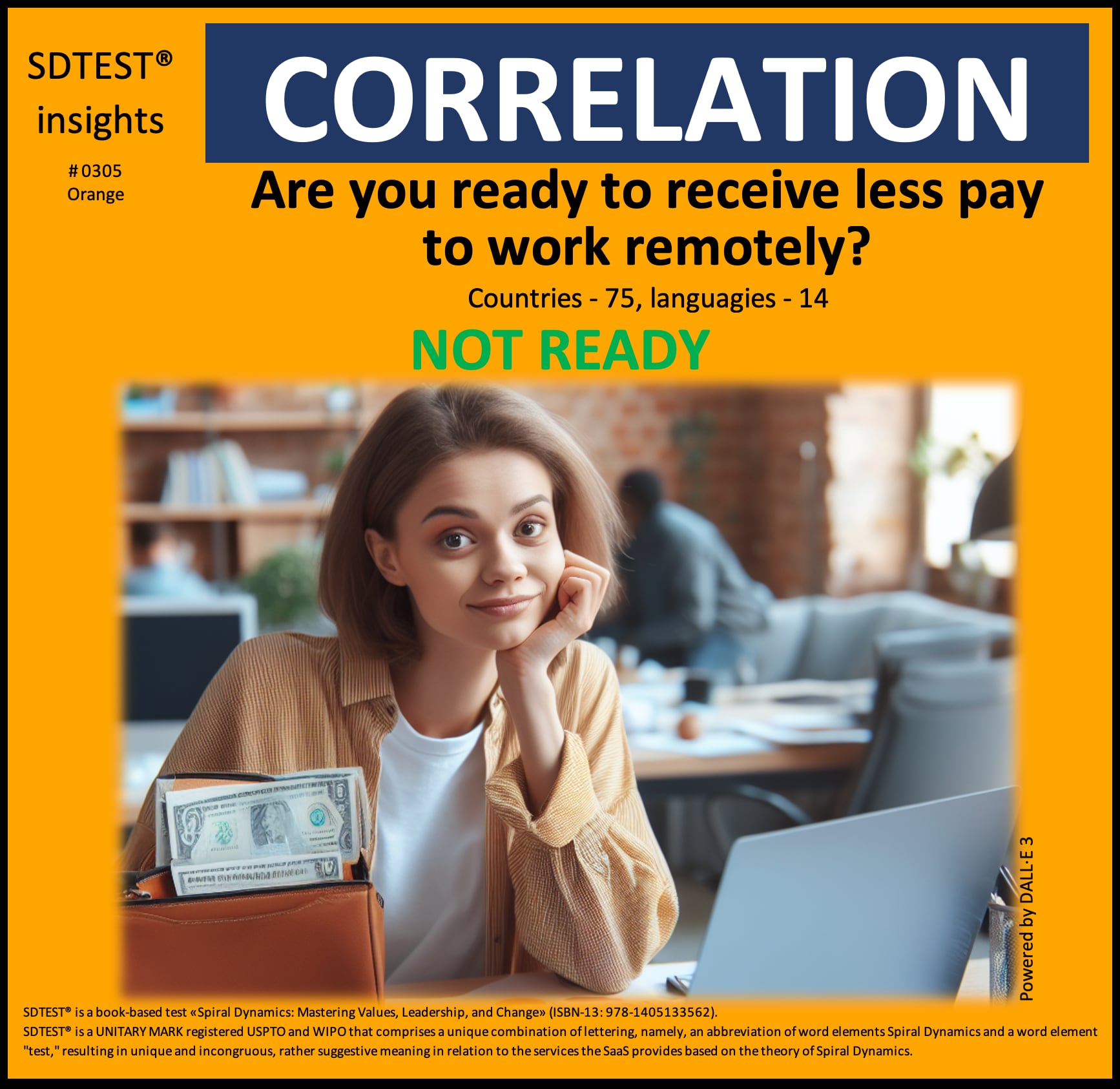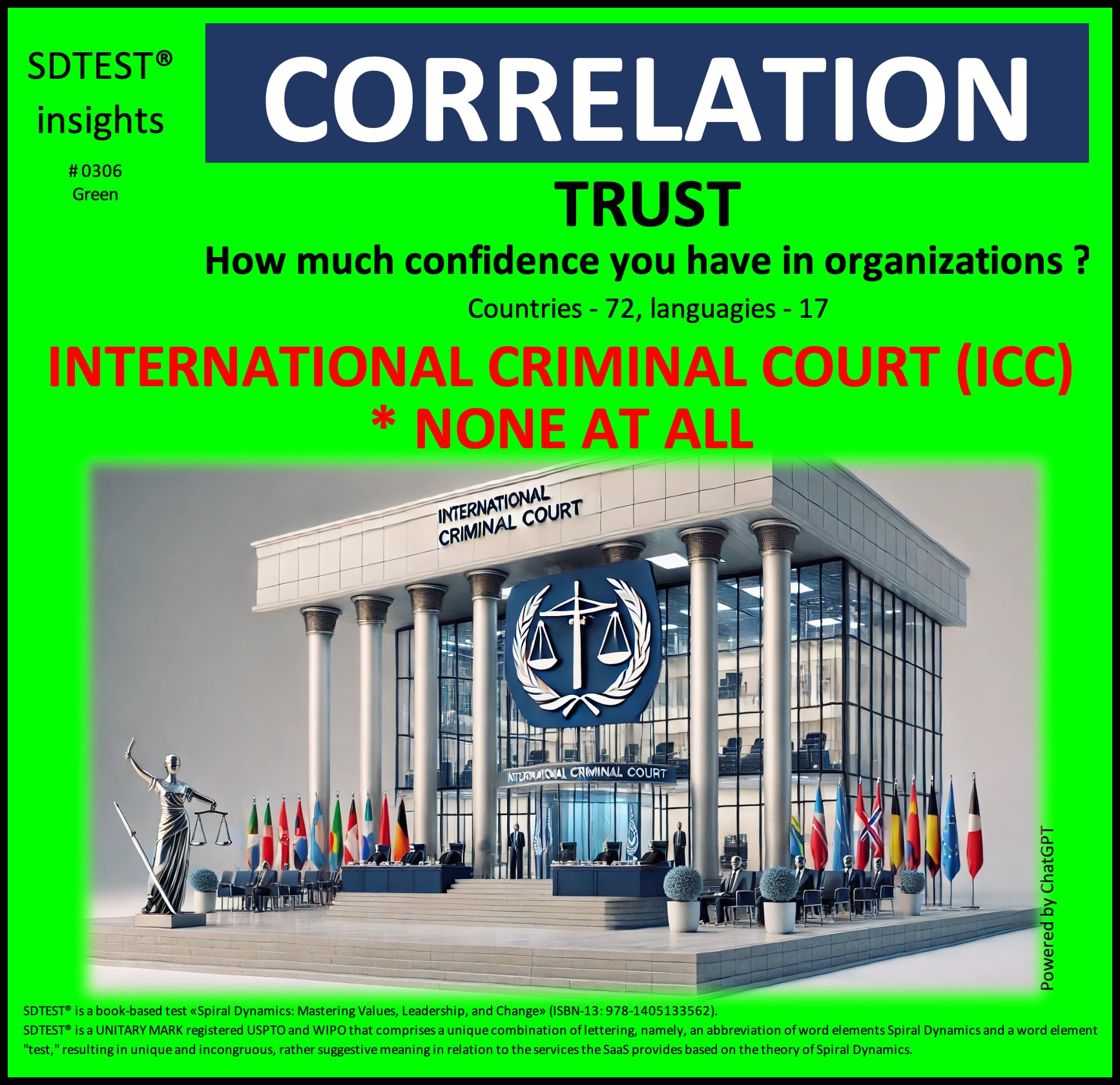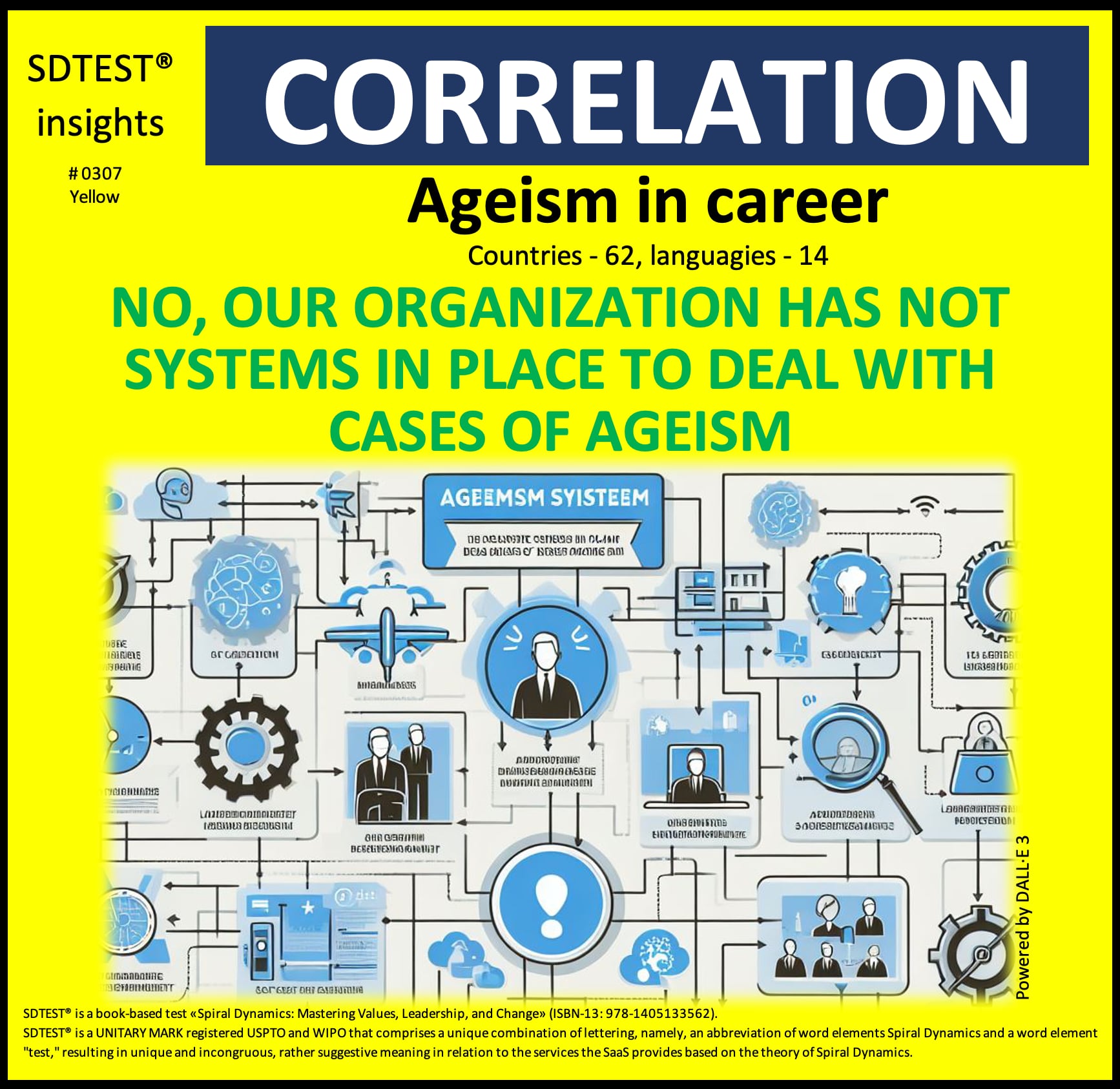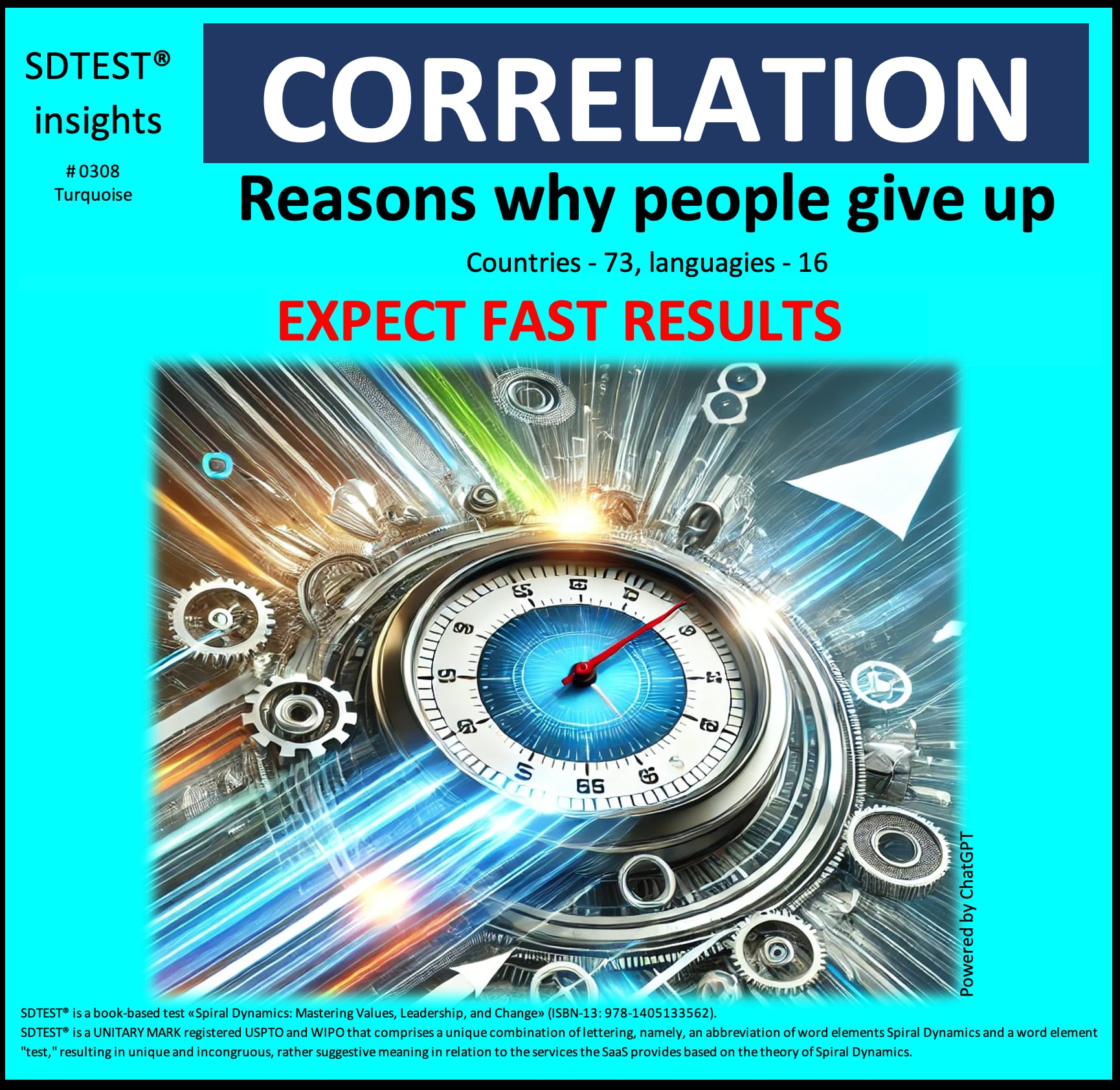SDTEST® has 36 different VUCA polls that calculate the 13,034 correlation values between stages of development according to the theory of Spiral Dynamics and answer options of these 36 polls.
We invite curiosity about the systemic mechanisms behind this correlation. There may be hidden variables that provide alternative explanations.
In our analysis of the poll "Algebra of Conscience" (by Vladimir Lefebvre), we found an intriguing positive correlation that warrants closer examination:
0.2846 between the Malefactor can be punished more severely than the law requires if this may serve as a deterrence for others / Strongly agree and the Purple stage.
The critical value of the correlation coefficient for a normal distribution, by William Sealy Gosset (Student) r = 0.2479. This positive correlation of 0.2846 meets the reliability criteria but does not necessarily imply causation.

This positive correlation of 0.2846 between severe punishment as deterrence and the Purple stage offers intriguing insights when viewed through the lens of the Purple value system:
Organizational Perspective:
Organizations operating within the Purple mindset might interpret this correlation as:
- Divine confirmation that traditional methods of severe punishment protect the tribe's spiritual harmony
- Validation that ancestral wisdom about deterrence through exemplary punishment remains sacred and true
- A mystical sign that maintaining spiritual order requires strong ritualistic responses to wrongdoing
These organizations might respond by:
- Creating ceremonial councils of elders to oversee justice rituals
- Establishing sacred spaces where traditional punishments are administered
- Implementing purification ceremonies for wrongdoers to cleanse the collective spirit
Team Perspective:
Teams operating from a Purple mindset might approach this correlation by:
- Viewing it as supernatural validation of their traditional protective practices
- Interpreting it as proof that tribal harmony requires strong spiritual boundaries
- Seeing it as confirmation that collective safety depends on ritualistic deterrence
These teams might respond by:
- Conducting regular cleansing ceremonies to ward off evil influences
- Creating sacred symbols and totems representing protective punishment
- Developing shared myths about the consequences of violating tribal taboos
Individual Perspective:
Individuals aligned with the Purple value system might interpret this correlation as:
- Personal confirmation of their role in maintaining spiritual harmony
- Evidence that individual sacrifice through severe punishment protects the tribe
- Validation of their belief in supernatural consequences for wrongdoing
These individuals might respond by:
- Accepting harsher punishment as a form of spiritual cleansing
- Participating in ceremonial acts of penance to protect others
- Sharing cautionary tales about the mystical consequences of misconduct
This correlation, viewed through the Purple lens, suggests that those operating at the Purple level may be more likely to support severe punishment as deterrence. It implies that the Purple value system's focus on tradition, ritual, and supernatural protection aligns with a more supportive approach to exemplary punishment for collective protection.
The reasons why severe punishment might be seen as necessary deterrence in the Purple stage could include:
- Spiritual Protection: Punishment is viewed as a ritual that maintains cosmic harmony
- Ancestral Wisdom: Traditional methods of punishment are seen as sacred knowledge
- Collective Safety: Severe consequences create protective spiritual barriers
- Supernatural Deterrence: Examples through punishment have mystical effects
- Tribal Purification: Harsh punishment serves as a cleansing ritual
This correlation prompts us to consider how different value systems influence perceptions of justice and deterrence. It raises questions about the potential benefits and drawbacks of a Purple approach to punishment, particularly in contexts where modern legal systems meet traditional beliefs.
Ultimately, this correlation highlights the complex interplay between spiritual beliefs, tribal protection, and justice systems. Severe punishment might be seen not as mere retribution but as a sacred duty to maintain supernatural harmony and protect the tribe through mystical deterrence.
In our analysis of the poll "What makes a boss a great leader?" we found an intriguing positive correlation that warrants closer examination:
0.0715 between the Trustworthiness and the Red stage.
The critical value of the correlation coefficient for a non-normal distribution, by Spearman r = 0.0017. This positive correlation of 0.0715 meets the reliability criteria but does not necessarily imply causation.

This positive correlation of 0.0715 between trustworthiness and the Red stage offers intriguing insights when viewed through the lens of the Red value system:
Organizational Perspective:
Organizations operating within the Red mindset might interpret this correlation as:
- Validation that trustworthy leaders command more power and respect
- Confirmation that loyalty to a strong leader drives organizational dominance
- Evidence that trusted leaders can more effectively enforce their will
These organizations might respond by:
- Rewarding leaders who demonstrate power through consistent dominance
- Implementing systems that showcase the leader's strength and reliability
- Promoting those who build loyal followings through demonstrated power
Team Perspective:
Teams operating from a Red mindset might approach this correlation by:
- Viewing it as proof that trustworthy leaders get better results through force
- Interpreting it as support for following the strongest, most reliable alpha
- Seeing it as validation for respecting leaders who consistently show their might
These teams might respond by:
- Aligning with leaders who consistently demonstrate their power
- Challenging leaders who fail to maintain their dominant position
- Creating power hierarchies based on proven track records of strength
Individual Perspective:
Individuals aligned with the Red value system might interpret this correlation as:
- Personal validation that being trustworthy increases their power
- Evidence that reliability can be weaponized for dominance
- Confirmation that consistent strength builds lasting authority
These individuals might respond by:
- Actively demonstrating their reliability in building power
- Using their trustworthiness to demand loyalty from others
- Leveraging their consistent track record to dominate competitors
This correlation, viewed through the Red lens, suggests that those operating at the Red level may view trustworthiness as a tool for power. It implies that the Red value system's focus on dominance and strength aligns with using reliability as a means of control.
The reasons why trustworthiness might be valued in a leader at the Red stage could include:
- Power Consolidation: Trustworthy leaders can maintain their dominance longer
- Force Multiplier: Reliability makes threats and promises more effective
- Control Mechanism: Consistent behavior makes it easier to command loyalty
- Competitive Edge: Being trustworthy can be weaponized against rivals
- Dominance Display: Reliability demonstrates sustained power over time
This correlation prompts us to consider how different value systems influence perceptions of leadership. It raises questions about the potential benefits of trustworthiness in Red-dominant environments where raw power is the primary currency.
Ultimately, this correlation highlights the complex interplay between trust, power, and leadership effectiveness. Trustworthiness might be seen not as a moral virtue but as a tactical advantage in establishing and maintaining dominance.
In our analysis of the poll "What makes people successful at work?" we found an intriguing negative correlation that warrants closer examination:
-0.0443 between the Adaptability to Change and the Blue stage.
The critical value of the correlation coefficient for a normal distribution, by William Sealy Gosset (Student) r = 0.0398. This negative correlation of -0.0443 meets the reliability criteria but does not necessarily imply causation.

This negative correlation of -0.0443 between Adaptability to Change and the Blue stage offers intriguing insights when viewed through the lens of the Blue value system:
Organizational Perspective:
Organizations operating within the Blue mindset might interpret this correlation as:
- Validation that stable, rule-bound structures are the foundation of success
- Confirmation that reliable, disciplined employees are more valuable than adaptable ones
- Evidence that adhering to time-honored traditions and procedures is the path to organizational greatness
These organizations might respond by:
- Prioritizing employees who demonstrate unwavering loyalty to company policies and procedures
- Implementing rigid hierarchies and bureaucratic processes to ensure order and predictability
- Resisting changes that disrupt established ways of doing things, even if they promise improved efficiency
Team Perspective:
Teams operating from a Blue mindset might approach this correlation by:
- Viewing it as proof that flexibility and adaptation are signs of weakness
- Interpreting it as support for enforcing strict protocols and punishing deviance
- Seeing it as validation for the importance of unquestioning obedience to leadership
These teams might respond by:
- Establishing stringent codes of conduct that leave no room for independent thinking
- Publicly shaming or ostracizing team members who challenge the status quo
- Revering leaders who demonstrate an unwavering commitment to tradition and rules
Individual Perspective:
Individuals aligned with the Blue value system might interpret this correlation as:
- Personal confirmation that their disciplined, dutiful approach to work is the righteous path
- Evidence that adaptability is a character flaw that undermines moral fiber
- Validation of their belief that success comes from unwavering adherence to higher authority
These individuals might respond by:
- Redoubling their efforts to follow all company policies and procedures meticulously
- Viewing any suggestion of change or flexibility as a temptation of the devil
- Seeking to rise through the ranks by demonstrating their steadfast loyalty to the system
This correlation, viewed through the Blue lens, suggests that those operating at the Blue level may see adaptability as a hindrance to success. It implies that the Blue value system's emphasis on order, rules, and tradition aligns with a preference for stable, predictable work environments over those that demand flexibility and innovation.
The reasons why adaptability might not be valued in the Blue stage could include:
- Moral Decay: Change is seen as a slippery slope towards moral relativism and societal collapse
- Obedience to Authority: Blindly following orders from above is more critical than individual initiative
- Respect for Tradition: Established ways of doing things are sacrosanct and should not be tampered with
- Avoidance of Uncertainty: Adaptability introduces chaos that threatens the security of the established order
- Maintenance of Hierarchy: Flexibility could disrupt the rigid chain of command that defines success
This correlation prompts us to consider how different value systems influence perceptions of what constitutes workplace success. It raises questions about the potential drawbacks of a Blue-dominated environment where rigid adherence to rules and traditions precedes innovative thinking and adaptability.
Ultimately, this correlation highlights the tension between stability and change within the Blue value system. Adaptability might be seen not as a virtue but as a threat to the moral and social order that defines true success.
In our analysis of the poll "Are you ready to receive less pay to work remotely?" we found an intriguing positive correlation that warrants closer examination:
0.1295 between the I am not ready to receive less pay to work remotely and the Orange stage.
The critical value of the correlation coefficient for a normal distribution, by William Sealy Gosset (Student) r = 0.0624. This positive correlation of 0.1295 meets the reliability criteria but does not necessarily imply causation.

This positive correlation of 0.1295 between not being ready to receive less pay for remote work and the Orange stage offers intriguing insights when viewed through the lens of the Orange value system:
Organizational Perspective:
Organizations operating within the Orange mindset would likely see the cost savings of remote work as a rational, logical opportunity to maximize efficiency and profits. However, they may interpret this correlation as:
- Confirmation that their employees value fair, results-oriented compensation above all else
- Evidence that remote work arrangements could disrupt their meritocratic, productivity-driven culture
- Indication that any attempts to share the cost savings with employees through pay reductions will be met with resistance
These organizations might respond by:
- Carefully calculating the potential cost savings of remote work and the associated productivity gains
- Communicating the rational, data-driven justification for modest pay adjustments to match the reduced expenses
- Emphasizing that fair, meritocratic compensation will remain the cornerstone of their reward system
Team Perspective:
Teams operating from an Orange mindset would likely see the personal benefits of remote work, such as reduced commuting costs and increased flexibility. However, they may approach this correlation by:
- Viewing it as proof that their colleagues are unwilling to accept any diminishment of their rational, performance-based compensation
- Interpreting it as a threat to the competitive, achievement-driven culture they have cultivated
- Seeing it as validation for the importance of tightly linking pay to quantifiable individual contributions
These teams might respond by:
- Advocating fiercely to maintain their current pay levels, even if remote work could reduce organizational costs
- Developing more sophisticated metrics and monitoring systems to track remote worker productivity
- Pushing back on any proposals to share the cost savings with employees through reduced compensation
Individual Perspective:
Individuals aligned with the Orange value system would likely recognize the personal financial benefits of remote work, such as savings on commuting and meals. However, they may interpret this correlation as:
- Personal confirmation that their rational, achievement-oriented approach to work deserves fair, commensurate compensation
- Evidence that they should not be penalized for refusing to accept less pay, as their contributions remain equally valuable
- Validation of their belief that they are entitled to be rewarded based on the objective merits of their individual performance
These individuals might respond by:
- Negotiating aggressively to maintain or increase their pay, regardless of the workplace location
- Seeking out employers who prioritize meritocratic, results-driven compensation structures
- Viewing any attempts to reduce their pay for remote work as an irrational and unfair penalty
This correlation highlights the tension between the potential cost savings of remote work and the Orange value system's strong emphasis on fair, performance-based compensation. While the data-driven, efficiency-focused Orange mindset would recognize the benefits, the deeply-rooted belief in meritocracy and individualistic rewards creates resistance to any pay reductions.
The key reasons for this disagreement, even with the potential cost savings, include:
- Meritocratic Mindset: Reduced pay for remote work is seen as an arbitrary penalty, not a rational trade-off
- Output-Driven Thinking: Employees believe their productivity and value should be the sole determinants of compensation
- Distrust of Tradition: Remote work policies are viewed as a return to outdated, inefficient practices that should not impact pay
- Competitive Instinct: Individuals are unwilling to accept "inferior" pay compared to their on-site peers
- Aversion to Inefficiency: Remote work may be perceived as less productive, undermining the rationale for pay adjustments
This correlation makes us consider how the Orange stage's focus on reason, science, and technology-driven progress might clash with practical realities around cost savings and work arrangements. It raises questions about how organizations can balance their interests with the firmly held beliefs of their Orange-stage employees.
Ultimately, this tension highlights the challenge of enacting change within an Orange-dominant environment that prizes rational, meritocratic rewards above all else. Navigating this dynamic will require careful communication, data-driven justification, and a nuanced understanding of the Orange mindset's core values.
In our analysis of the poll "Trust" (by WVS) [Could you tell us how much confidence you have in organizations?], we found an intriguing negative correlation that warrants closer examination:
-0.1167 between the International Criminal Court (ICC) / None at all and the Green stage.
The critical value of the correlation coefficient for a normal distribution, by William Sealy Gosset (Student) r = 0.0634. This negative correlation of -0.1167 meets the reliability criteria but does not necessarily imply causation.

This negative correlation of -0.1167 between lack of trust in the International Criminal Court (ICC) and the Green stage offers intriguing insights when viewed through the lens of the Green value system:
Organizational Perspective:
Organizations operating within the Green mindset would likely interpret this negative correlation of -0.1167 between "None at all" trust in the ICC and the Green stage as strong validation of their values and priorities. They would see it as:
- Confirmation that their commitment to global cooperation, inclusivity, and impartial justice aligns with a deep trust in institutions like the ICC
- Evidence that their stakeholders expect them to actively support and collaborate with supranational bodies dedicated to upholding human rights and the rule of law
- Indication that their sustainability-focused mission and community-driven decision-making processes are enhanced by faith in the ICC's role in addressing complex, cross-border challenges
These organizations might respond by:
- Prominently featuring their support for the ICC and its work in their external messaging and internal policies
- Actively partnering with the ICC on relevant initiatives and advocating for the strengthening of international legal frameworks
- Encouraging employees and customers to learn more about the ICC and get involved in supporting its efforts
Team Perspective:
Teams operating from a Green mindset would likely view this negative correlation as a robust validation of their commitment to collaborative, systems-thinking approaches to problem-solving. They may interpret it as:
- Proof that their holistic understanding of global interconnectedness aligns with trust in impartial, transnational institutions like the ICC
- Confirmation that their emphasis on empathy, inclusivity, and environmental stewardship is enhanced by faith in the ICC's mission
- Evidence that their team's focus on consensus-driven decision-making and collective action resonates with the ICC's role in promoting international justice and human rights
These teams might respond by:
- Actively educating themselves and their wider networks about the ICC's purpose, activities, and impact
- Integrating support for the ICC and its work into their team's goals, decision-making processes, and external engagement
- Seeking out opportunities to collaborate with other like-minded teams and organizations to amplify the global movement behind the ICC
Individual Perspective:
Individuals aligned with the Green value system would likely see this negative correlation as a personal affirmation of their deeply held beliefs and values. They may interpret it as:
- Validation that their commitment to social and environmental justice is reflected in their strong trust in impartial, international institutions like the ICC
- Evidence that their conviction in the interconnectedness of all people and the need for collective action to address global challenges is strengthened by the ICC's mandate
- Confirmation that their desire for a more equitable, sustainable, and peaceful world is closely aligned with the principles and activities of the ICC
These individuals might respond by:
- Actively engaging with the ICC through volunteering, donations, or participating in awareness-raising campaigns
- Encouraging their friends, family, and community to learn more about the ICC and its work and to support its efforts actively
- Seeking out career opportunities or leadership roles within organizations that prioritize collaboration with the ICC and other international bodies
This negative correlation highlights the strong alignment between the Green value system's emphasis on holistic, systems-thinking, community, and concern for the greater good and a deep trust in the role of impartial, supranational institutions like the International Criminal Court (ICC).
The reasons why Green-stage individuals and organizations might place greater trust in the ICC include:
- Commitment to Global Cooperation: The ICC's mission to address cross-border issues through international collaboration resonates with Green values
- Belief in Impartial, Neutral Justice: The ICC's status as an independent, non-partisan institution appeals to the Green emphasis on fairness and inclusion
- Concern for Human Rights and Well-being: The ICC's focus on prosecuting war crimes, crimes against humanity, and other human rights abuses aligns with Green priorities
- Holistic, Systems-Thinking Approach: The ICC's role in addressing complex, interconnected global challenges fits with the Green mindset's understanding of the world as a complex, interdependent system
- Desire for Ecological Sustainability: The ICC's potential to hold accountable those responsible for environmental destruction or exploitation resonates with Green values of environmental stewardship
This correlation prompts us to consider how the Green value system's emphasis on community, cooperation, and global consciousness might influence perceptions of the importance and trustworthiness of international institutions like the ICC. It raises questions about the potential for deeper collaboration between Green-dominant organizations and the ICC to further their shared goals of promoting justice, human rights, and ecological sustainability on a global scale.
Ultimately, this correlation highlights the alignment between the Green value system's holistic, inclusive worldview and the ICC's mandate to address complex, transnational issues through impartial, cooperative approaches. Trust in the ICC might be seen not merely as a political stance but as a reflection of the Green Stage's commitment to a more equitable, sustainable, and interconnected global community.
In our analysis of the poll "Ageism in Career," we found an intriguing positive correlation that warrants closer examination:
0.0821 between the No, our organization has no systems in place to deal with cases of ageism and the Yellow stage.
The critical value of the correlation coefficient for a normal distribution, by William Sealy Gosset (Student) r = 0.0796. This positive correlation of 0.0821 meets the reliability criteria but does not necessarily imply causation.

This positive correlation of 0.0821 between organizations having no systems in place to deal with ageism and the Yellow stage offers intriguing insights when viewed through the lens of the Yellow value system:
Organizational Perspective:
Companies operating within the Yellow value system might interpret this correlation in a nuanced, multifaceted way. They would likely see it as:
- An indication that their holistic, integrative approach to understanding complex organizational dynamics may lead them to view ageism as just one facet of a more extensive, interconnected system.
- Evidence that their emphasis on personal growth and development, rather than rigid adherence to rules or hierarchies, shapes their approach to addressing workplace biases.
- Confirmation that their ability to transcend previous value systems and consider multiple perspectives simultaneously prevents them from relying on simplistic, one-size-fits-all policies to tackle ageism.
These organizations might respond by:
- Conducting in-depth, systems-level analyses to identify the root causes and interconnected factors contributing to ageism within their workplace.
- Implementing flexible, customizable programs that empower employees of all ages to engage in continuous learning, mentorship, and collaborative problem-solving.
- Fostering a culture that celebrates the diverse strengths and perspectives that employees of different ages bring to the organization.
Team Perspective:
Teams operating within the Yellow value system would likely approach this correlation with a nuanced, holistic understanding. They may interpret it as:
- Proof that their ability to see multiple sides of complex issues prevents them from adopting a rigid, rule-based approach to addressing ageism.
- Confirmation that their focus on personal growth and development, rather than conformity to organizational hierarchies, shapes their approach to workplace challenges.
- Evidence that their systems-level thinking leads them to view ageism as part of a broader, interconnected set of factors influencing team dynamics and performance.
These teams might respond by:
- Engaging in open, collaborative discussions to develop shared, team-wide understandings of the diverse factors contributing to ageism in the workplace.
- Implementing flexible, customizable programs that empower team members of all ages to share knowledge, mentor one another, and collectively problem-solve.
- Cultivating a team culture that celebrates the unique strengths and perspectives that employees of different ages bring to the table.
Individual Perspective:
Individuals operating within the Yellow value system would likely interpret this correlation through a multifaceted, integrative lens. They may see it as:
- Confirmation that their ability to transcend rigid, rule-bound approaches to addressing workplace challenges aligns with organizations that do not have simplistic, one-size-fits-all policies in place to deal with ageism.
- Evidence that their focus on personal growth and development, rather than conformity to hierarchical norms, shapes their expectations and perceptions of how organizations should address complex issues like ageism.
- Indication that their systems-level understanding of the interconnected factors contributing to workplace biases prevents them from relying on superficial, reactive solutions to problems.
These individuals might respond by:
- Actively engaging with their organizations to help facilitate open, collaborative discussions about the root causes and systemic factors contributing to ageism in the workplace.
- Advocating for implementing flexible, customizable programs and initiatives that empower employees of all ages to share knowledge, mentor one another, and collectively problem-solve.
- Modeling a personal approach to the workplace that celebrates the diverse strengths and perspectives that employees of different ages bring to the table.
This positive correlation highlights the unique perspective that the Yellow value system brings to the challenge of addressing ageism in the workplace. Rather than relying on rigid, rule-based policies or simplistic, reactive solutions, those operating within the Yellow mindset would likely approach this issue with a more nuanced, integrative understanding.
The reasons why Yellow-stage organizations, teams, and individuals may not have traditional "systems in place" to deal with ageism include:
- Holistic, Systems-Level Thinking: The Yellow value system's emphasis on understanding complex, interconnected factors would lead them to view ageism as part of a broader, systemic challenge.
- Focus on Personal Growth: The Yellow stage's focus on continuous learning and development, rather than conformity to organizational hierarchies, may shape their approach to addressing workplace biases.
- Transcendence of Previous Value Systems: The Yellow stage's ability to integrate and move beyond the limitations of earlier value systems prevents them from relying on simplistic, one-size-fits-all policies.
- Embrace Diverse Perspectives: The Yellow stage's appreciation for the unique strengths and viewpoints of employees of different ages may lead them to cultivate more flexible, customizable solutions.
- Systems-Level Intervention: The Yellow stage's systems-level understanding may lead them to focus on addressing the root causes and interconnected factors contributing to ageism rather than implementing reactive, surface-level policies.
This correlation makes us consider how the Yellow value system's holistic, integrative approach to complex challenges might shape organizational and individual responses to workplace ageism. It raises questions about this multifaceted perspective's potential benefits and drawbacks and how it might complement or diverge from traditional, rule-based approaches to addressing bias and discrimination.
Ultimately, this correlation highlights the Yellow stage's unique ability to transcend the limitations of previous value systems and consider the nuanced, interconnected nature of workplace dynamics. Addressing ageism through this lens may require a more customized, systems-level approach that empowers personal growth and development rather than relying on rigid, one-size-fits-all policies.
In our analysis of the poll "Reasons why people give up" (by Anna Vital [1]), we found an intriguing negative correlation that warrants closer examination:
-0.0577 between the Expect fast results and the Turquoise stage.
The critical value of the correlation coefficient for a normal distribution, by William Sealy Gosset (Student) r = 0.0565. This negative correlation of -0.0577 meets the reliability criteria but does not necessarily imply causation.

This negative correlation of -0.0577 between expecting fast results and the Turquoise stage reveals fascinating insights when viewed through the Turquoise value system lens:
Organizational Perspective:
Organizations operating within the Turquoise mindset might interpret this correlation as:
- Validation of their systems-thinking approach to organizational development
- Confirmation that sustainable transformation requires patience and holistic understanding
- Evidence supporting their belief in natural cycles of growth and evolution
These organizations might respond by:
- Implementing long-term sustainability metrics alongside traditional KPIs
- Creating spaces for emergent solutions rather than rushing to quick fixes
- Developing leadership practices that honor both immediate needs and long-term evolution
Team Perspective:
Teams operating from a Turquoise mindset might approach this correlation by:
- Viewing it as confirmation of their integrated approach to problem-solving
- Interpreting it as support for their focus on systemic rather than symptomatic solutions
- Seeing it as validation for prioritizing sustainable progress over quick wins
These teams might respond by:
- Adopting rhythmic planning cycles that align with natural development patterns
- Encouraging deep listening and collective wisdom emergence
- Celebrating incremental progress while maintaining focus on long-term vision
Individual Perspective:
Individuals aligned with the Turquoise value system might interpret this correlation as:
- Personal validation of their holistic worldview
- Evidence supporting their intuitive understanding of natural development cycles
- Confirmation of the value they place on authentic, sustainable growth
These individuals might respond by:
- Deepening their practice of systems thinking
- Viewing patience as a strength in personal and professional development
- Using their understanding of natural cycles to guide decision-making
This correlation, viewed through the Turquoise lens, suggests that those operating at this level have transcended the need for immediate gratification. It implies that the Turquoise value system's holistic perspective and ecological awareness align with a more mature approach to expectations and outcomes.
The reasons why people don't give up expecting fast results in the Turquoise stage could include:
- Integrated Understanding: They recognize that both quick wins and long-term evolution have their place in natural systems
- Holistic Perspective: They can hold both immediate and long-term timeframes simultaneously
- Systems Awareness: They understand that change happens at multiple speeds within complex systems
- Ecological Wisdom: They've internalized natural growth patterns that include both rapid and gradual change
- Spiritual Maturity: They trust in the unfolding of processes while remaining actively engaged
This correlation makes us consider how different value systems influence perceptions of time and progress. It raises questions about the relationship between consciousness development and temporal expectations, particularly in contexts where sustainable transformation is crucial.
Ultimately, this correlation highlights the interplay between consciousness evolution, systemic understanding, and change expectations. The negative correlation might indicate not rejecting fast results but rather a transcendence of the either/or thinking about speed of change.
What insights do you gain from today's correlation? How might we study this relationship more carefully before deducing causation?
We welcome respectful and wise perspectives! Stay tuned every week as we share more results and insights.
After login or registration, free access to the poll results in the FAQ section.
[1] https://www.linkedin.com/in/annavital/
2024.11.03
FearpersonqualitiesprojectorganizationalstructureRACIresponsibilitymatrixCritical ChainProject Managementfocus factorJiraempathyleadersbossGermanyChinaPolicyUkraineRussiawarvolatilityuncertaintycomplexityambiguityVUCArelocatejobproblemcountryreasongive upobjectivekeyresultmathematicalpsychologyMBTIHR metricsstandardDEIcorrelationriskscoringmodelGame TheoryPrisoner's Dilemma
Valerii Kosenko
產品負責人 SaaS SDTEST®
Valerii 於 1993 年獲得社會教育心理學家資格,此後將他的知識應用於專案管理。
Valerii 於 2013 年獲得碩士學位以及專案和專案經理資格。
Valerii 是探討 V.U.C.A. 不確定性的作者。使用螺旋動力學和心理學數理統計的概念,以及 38 個國際民意調查。










